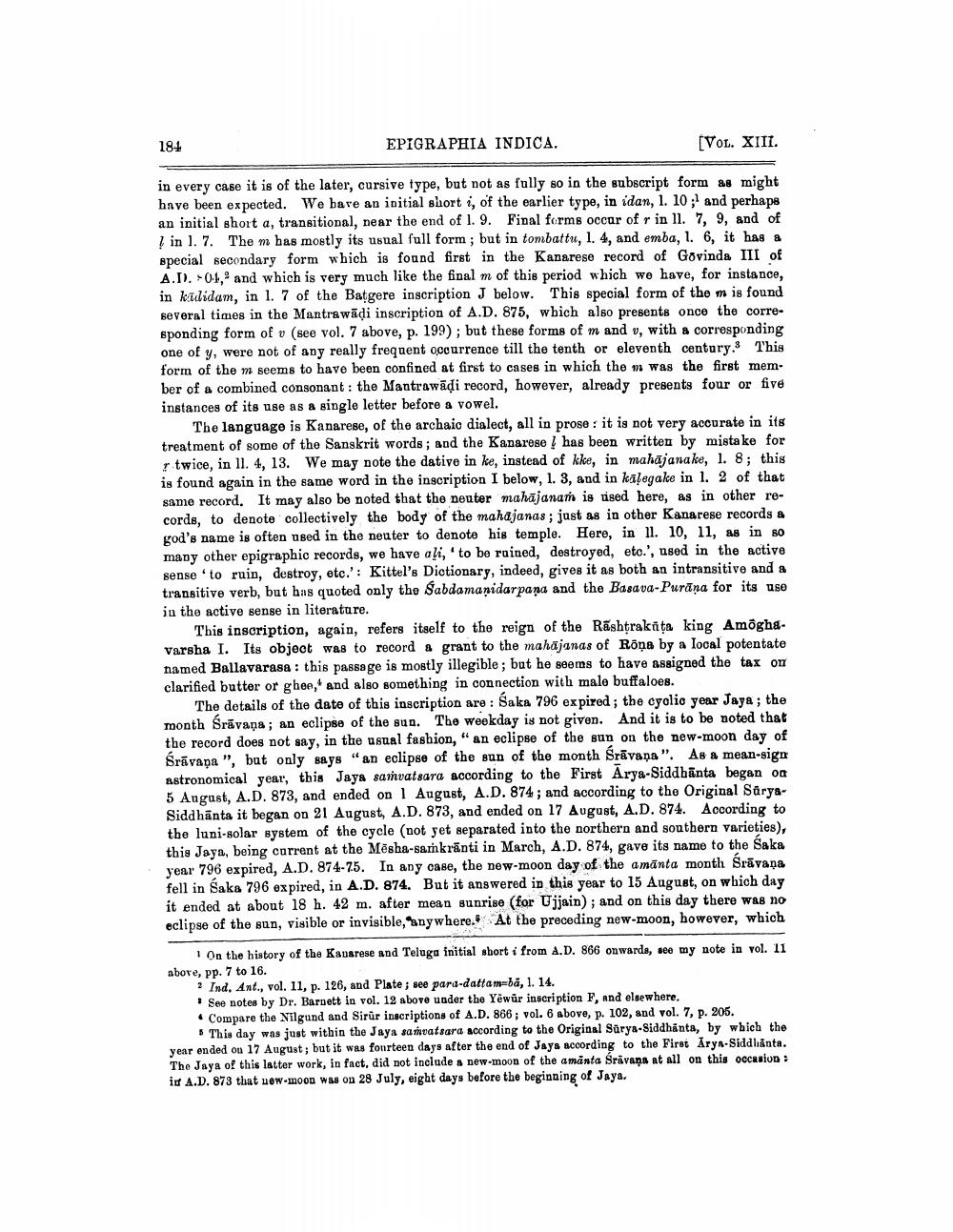________________
184
EPIGRAPHIA INDICA.
(VOL. XIII.
in every case it is of the later, cursive type, but not as fully so in the subscript form as might hnve been expected. We have an initial short i, of the earlier type, in idan, 1. 10;' and perhaps an initial short a, transitional, near the end of 1. 9. Final forms occur of r in 11. 7, 9, and of I in 1. 7. The mbas mostly its usual full form ; but in tombattu, 1. 4, and emba, 1. 6, it has a special secondary form which is found first in the Kanarese record of Govinda III of A.I). 01,* and which is very much like the final m of this period which we have, for instance, in kuidam, in 1.7 of the Batgere inscription J below. This special form of the m is found several times in the Mantra wādi inscription of A.D. 875, which also presents once the corresponding form of v (see vol. 7 above, p. 199); but these forms of m and v, with a corresponding one of y, were not of any really frequent occurrence till the tenth or eleventh century. This form of the m seems to have been confined at first to cases in which the m was the first member of a combined consonant: the Mantrawāļi record, however, already presents four or five instances of its use as a single letter before a vowel.
The language is Kanarese, of the archaic dialect, all in prose : it is not very accurate in its treatment of some of the Sanskrit words; and the Kanarese has been written by mistake for r twice, in ll. 4, 13. We may note the dative in ke, instead of kke, in mahājanake, 1. 8; this is found again in the same word in the inscription I below, 1.3, and in kīļegake in l. 2 of that same record. It may also be noted that the neuter mahājanam is used here, as in other records, to denote collectively the body of the mahajanas; just as in other Kanarese records a god's name is often used in the neuter to denote his temple. Here, in ll. 10, 11, as in so many other epigraphic records, we have ali, 'to be rained, destroyed, etc.', used in the active sense to ruin, destroy, etc.': Kittel's Dictionary, indeed, gives it as both an intransitive and a transitive verb, but has quoted only the Sabdamanidar pana and the Basava-Purāna for its use in the active sense in literature.
This inscription, again, refers itself to the reign of the Rashtrakūta king AmõghaVarsha I. Its object was to record a grant to the mahājanas of Rõns by a local potentate named Ballavarasa : this passage is mostly illegible; but he seems to have assigned the tax on clarified butter or ghee, and also something in connection with male buffaloes.
The details of the date of this inscription are: Saka 796 expired; the cyclio year Jaya; the month Srāvans; an eclipse of the sun. The weekday is not given. And it is to be noted that the record does not say, in the usual fashion," an eclipse of the sun on the new-moon day of Śrāvana", but only says “an eclipse of the son of the month Srāvana". As a mean-sign astronomical year, this Jaya samvatsara according to the First Arya-Siddhanta began on 5 August, A.D. 873, and ended on 1 August, A.D. 874 ; and according to the Original SäryaSiddhānta it began on 21 August, A.D. 873, and ended on 17 August, A.D. 874. According to the luni-solar system of the cycle (not yet separated into the northern and southern varieties), this Jaya, being current at the Mēsha-samkrānti in March, A.D. 874, gave its name to the Saka year 796 expired, A.D. 874-75. In any case, the new-moon day of the amānta month Srāvana fell in Saka 796 expired, in A.D. 874. But it answered in this year to 15 August, on which day it ended at about 18 h. 42 m. after mean sunrise (for Ujjain); and on this day there was no eclipse of the sun, visible or invisible, anywhere. At the preceding new-moon, however, which
1 On the history of the Kauarese and Teluga initial short í from A.D. 866 onwards, see my note in vol. 11 abore, pp. 7 to 16.
? Ind. Ant., vol. 11, p. 126, and Plate; see para-dattam=bā, 1. 14. + See notes by Dr. Barnett in vol. 12 above under the Yewur inscription F, and elsewhere. • Compare the Nilgund and Sirur inscriptions of A.D. 866 ; vol. 6 above, p. 102, and vol. 7, p. 205.
* This day was just within the Jaya sa matsara according to the Original Sürya-Siddhanta, by which the year ended on 17 August, but it was fourteen days after the end of Jays according to the First Arya-Siddhanta. The Jaya of this latter work, in fact, did not include a new-moon of the amānta Sravana at all on this occasion : it A.D. 873 that uew-moon was on 28 July, eight days before the beginning of Jaya.




